Input interpretation

CO_2 (carbon dioxide) + Ca(OH)_2 (calcium hydroxide) ⟶ H_2O (water) + CaCO_3 (calcium carbonate)
Balanced equation
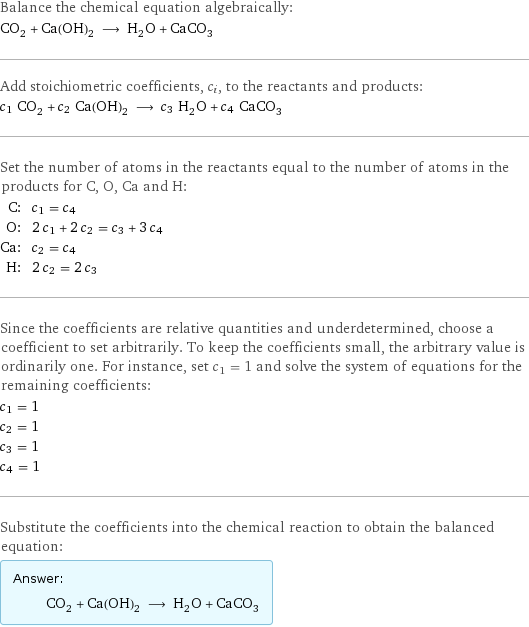
Balance the chemical equation algebraically: CO_2 + Ca(OH)_2 ⟶ H_2O + CaCO_3 Add stoichiometric coefficients, c_i, to the reactants and products: c_1 CO_2 + c_2 Ca(OH)_2 ⟶ c_3 H_2O + c_4 CaCO_3 Set the number of atoms in the reactants equal to the number of atoms in the products for C, O, Ca and H: C: | c_1 = c_4 O: | 2 c_1 + 2 c_2 = c_3 + 3 c_4 Ca: | c_2 = c_4 H: | 2 c_2 = 2 c_3 Since the coefficients are relative quantities and underdetermined, choose a coefficient to set arbitrarily. To keep the coefficients small, the arbitrary value is ordinarily one. For instance, set c_1 = 1 and solve the system of equations for the remaining coefficients: c_1 = 1 c_2 = 1 c_3 = 1 c_4 = 1 Substitute the coefficients into the chemical reaction to obtain the balanced equation: Answer: | | CO_2 + Ca(OH)_2 ⟶ H_2O + CaCO_3
Structures

+ ⟶ +
Names

carbon dioxide + calcium hydroxide ⟶ water + calcium carbonate
Reaction thermodynamics
Enthalpy
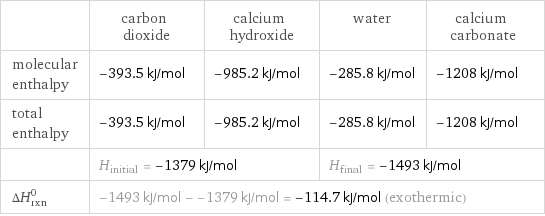
| carbon dioxide | calcium hydroxide | water | calcium carbonate molecular enthalpy | -393.5 kJ/mol | -985.2 kJ/mol | -285.8 kJ/mol | -1208 kJ/mol total enthalpy | -393.5 kJ/mol | -985.2 kJ/mol | -285.8 kJ/mol | -1208 kJ/mol | H_initial = -1379 kJ/mol | | H_final = -1493 kJ/mol | ΔH_rxn^0 | -1493 kJ/mol - -1379 kJ/mol = -114.7 kJ/mol (exothermic) | | |
Gibbs free energy

| carbon dioxide | calcium hydroxide | water | calcium carbonate molecular free energy | -394.4 kJ/mol | -897.5 kJ/mol | -237.1 kJ/mol | -1129 kJ/mol total free energy | -394.4 kJ/mol | -897.5 kJ/mol | -237.1 kJ/mol | -1129 kJ/mol | G_initial = -1292 kJ/mol | | G_final = -1366 kJ/mol | ΔG_rxn^0 | -1366 kJ/mol - -1292 kJ/mol = -74.3 kJ/mol (exergonic) | | |
Entropy
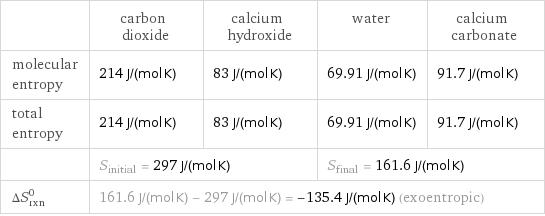
| carbon dioxide | calcium hydroxide | water | calcium carbonate molecular entropy | 214 J/(mol K) | 83 J/(mol K) | 69.91 J/(mol K) | 91.7 J/(mol K) total entropy | 214 J/(mol K) | 83 J/(mol K) | 69.91 J/(mol K) | 91.7 J/(mol K) | S_initial = 297 J/(mol K) | | S_final = 161.6 J/(mol K) | ΔS_rxn^0 | 161.6 J/(mol K) - 297 J/(mol K) = -135.4 J/(mol K) (exoentropic) | | |
Equilibrium constant
![Construct the equilibrium constant, K, expression for: CO_2 + Ca(OH)_2 ⟶ H_2O + CaCO_3 Plan: • Balance the chemical equation. • Determine the stoichiometric numbers. • Assemble the activity expression for each chemical species. • Use the activity expressions to build the equilibrium constant expression. Write the balanced chemical equation: CO_2 + Ca(OH)_2 ⟶ H_2O + CaCO_3 Assign stoichiometric numbers, ν_i, using the stoichiometric coefficients, c_i, from the balanced chemical equation in the following manner: ν_i = -c_i for reactants and ν_i = c_i for products: chemical species | c_i | ν_i CO_2 | 1 | -1 Ca(OH)_2 | 1 | -1 H_2O | 1 | 1 CaCO_3 | 1 | 1 Assemble the activity expressions accounting for the state of matter and ν_i: chemical species | c_i | ν_i | activity expression CO_2 | 1 | -1 | ([CO2])^(-1) Ca(OH)_2 | 1 | -1 | ([Ca(OH)2])^(-1) H_2O | 1 | 1 | [H2O] CaCO_3 | 1 | 1 | [CaCO3] The equilibrium constant symbol in the concentration basis is: K_c Mulitply the activity expressions to arrive at the K_c expression: Answer: | | K_c = ([CO2])^(-1) ([Ca(OH)2])^(-1) [H2O] [CaCO3] = ([H2O] [CaCO3])/([CO2] [Ca(OH)2])](../image_source/31ca07c448ffd732fafc743bb1518a13.png)
Construct the equilibrium constant, K, expression for: CO_2 + Ca(OH)_2 ⟶ H_2O + CaCO_3 Plan: • Balance the chemical equation. • Determine the stoichiometric numbers. • Assemble the activity expression for each chemical species. • Use the activity expressions to build the equilibrium constant expression. Write the balanced chemical equation: CO_2 + Ca(OH)_2 ⟶ H_2O + CaCO_3 Assign stoichiometric numbers, ν_i, using the stoichiometric coefficients, c_i, from the balanced chemical equation in the following manner: ν_i = -c_i for reactants and ν_i = c_i for products: chemical species | c_i | ν_i CO_2 | 1 | -1 Ca(OH)_2 | 1 | -1 H_2O | 1 | 1 CaCO_3 | 1 | 1 Assemble the activity expressions accounting for the state of matter and ν_i: chemical species | c_i | ν_i | activity expression CO_2 | 1 | -1 | ([CO2])^(-1) Ca(OH)_2 | 1 | -1 | ([Ca(OH)2])^(-1) H_2O | 1 | 1 | [H2O] CaCO_3 | 1 | 1 | [CaCO3] The equilibrium constant symbol in the concentration basis is: K_c Mulitply the activity expressions to arrive at the K_c expression: Answer: | | K_c = ([CO2])^(-1) ([Ca(OH)2])^(-1) [H2O] [CaCO3] = ([H2O] [CaCO3])/([CO2] [Ca(OH)2])
Rate of reaction
![Construct the rate of reaction expression for: CO_2 + Ca(OH)_2 ⟶ H_2O + CaCO_3 Plan: • Balance the chemical equation. • Determine the stoichiometric numbers. • Assemble the rate term for each chemical species. • Write the rate of reaction expression. Write the balanced chemical equation: CO_2 + Ca(OH)_2 ⟶ H_2O + CaCO_3 Assign stoichiometric numbers, ν_i, using the stoichiometric coefficients, c_i, from the balanced chemical equation in the following manner: ν_i = -c_i for reactants and ν_i = c_i for products: chemical species | c_i | ν_i CO_2 | 1 | -1 Ca(OH)_2 | 1 | -1 H_2O | 1 | 1 CaCO_3 | 1 | 1 The rate term for each chemical species, B_i, is 1/ν_i(Δ[B_i])/(Δt) where [B_i] is the amount concentration and t is time: chemical species | c_i | ν_i | rate term CO_2 | 1 | -1 | -(Δ[CO2])/(Δt) Ca(OH)_2 | 1 | -1 | -(Δ[Ca(OH)2])/(Δt) H_2O | 1 | 1 | (Δ[H2O])/(Δt) CaCO_3 | 1 | 1 | (Δ[CaCO3])/(Δt) (for infinitesimal rate of change, replace Δ with d) Set the rate terms equal to each other to arrive at the rate expression: Answer: | | rate = -(Δ[CO2])/(Δt) = -(Δ[Ca(OH)2])/(Δt) = (Δ[H2O])/(Δt) = (Δ[CaCO3])/(Δt) (assuming constant volume and no accumulation of intermediates or side products)](../image_source/9a33721cdcda3d030bbbf4e68490acc9.png)
Construct the rate of reaction expression for: CO_2 + Ca(OH)_2 ⟶ H_2O + CaCO_3 Plan: • Balance the chemical equation. • Determine the stoichiometric numbers. • Assemble the rate term for each chemical species. • Write the rate of reaction expression. Write the balanced chemical equation: CO_2 + Ca(OH)_2 ⟶ H_2O + CaCO_3 Assign stoichiometric numbers, ν_i, using the stoichiometric coefficients, c_i, from the balanced chemical equation in the following manner: ν_i = -c_i for reactants and ν_i = c_i for products: chemical species | c_i | ν_i CO_2 | 1 | -1 Ca(OH)_2 | 1 | -1 H_2O | 1 | 1 CaCO_3 | 1 | 1 The rate term for each chemical species, B_i, is 1/ν_i(Δ[B_i])/(Δt) where [B_i] is the amount concentration and t is time: chemical species | c_i | ν_i | rate term CO_2 | 1 | -1 | -(Δ[CO2])/(Δt) Ca(OH)_2 | 1 | -1 | -(Δ[Ca(OH)2])/(Δt) H_2O | 1 | 1 | (Δ[H2O])/(Δt) CaCO_3 | 1 | 1 | (Δ[CaCO3])/(Δt) (for infinitesimal rate of change, replace Δ with d) Set the rate terms equal to each other to arrive at the rate expression: Answer: | | rate = -(Δ[CO2])/(Δt) = -(Δ[Ca(OH)2])/(Δt) = (Δ[H2O])/(Δt) = (Δ[CaCO3])/(Δt) (assuming constant volume and no accumulation of intermediates or side products)
Chemical names and formulas
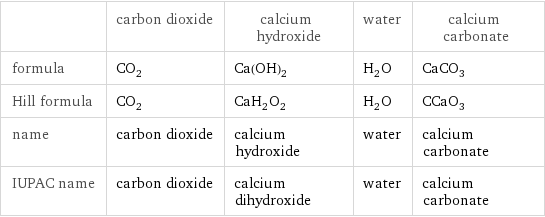
| carbon dioxide | calcium hydroxide | water | calcium carbonate formula | CO_2 | Ca(OH)_2 | H_2O | CaCO_3 Hill formula | CO_2 | CaH_2O_2 | H_2O | CCaO_3 name | carbon dioxide | calcium hydroxide | water | calcium carbonate IUPAC name | carbon dioxide | calcium dihydroxide | water | calcium carbonate
Substance properties
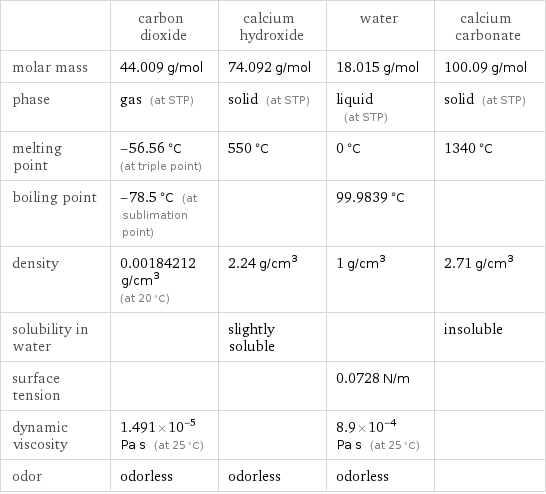
| carbon dioxide | calcium hydroxide | water | calcium carbonate molar mass | 44.009 g/mol | 74.092 g/mol | 18.015 g/mol | 100.09 g/mol phase | gas (at STP) | solid (at STP) | liquid (at STP) | solid (at STP) melting point | -56.56 °C (at triple point) | 550 °C | 0 °C | 1340 °C boiling point | -78.5 °C (at sublimation point) | | 99.9839 °C | density | 0.00184212 g/cm^3 (at 20 °C) | 2.24 g/cm^3 | 1 g/cm^3 | 2.71 g/cm^3 solubility in water | | slightly soluble | | insoluble surface tension | | | 0.0728 N/m | dynamic viscosity | 1.491×10^-5 Pa s (at 25 °C) | | 8.9×10^-4 Pa s (at 25 °C) | odor | odorless | odorless | odorless |
Units
